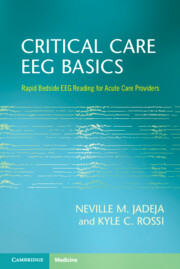Book contents
- Critical Care EEG Basics
- Critical Care EEG Basics
- Copyright page
- Dedication
- Contents
- Foreword
- Preface
- Acknowledgments
- How to Read This Book
- Part I Introduction
- Chapter 1 EEG Basics
- Chapter 2 Indications
- Chapter 3 Real-Time Bedside EEG Reading
- Chapter 4 Recognizing Artifacts and Medication Effects
- Chapter 5 Epileptiform Discharges, Seizures, and Status Epilepticus
- Chapter 6 Rhythmic and Periodic Patterns (RPPs) and the Ictal‐Interictal Continuum (IIC)
- Chapter 7 Post–Cardiac Arrest EEG
- Chapter 8 Quantitative EEG (EEG Trend Analysis)
- Part II Case-Based Approach to Specific Conditions
- Appendix Understanding EEG Reports
- Index
- References
Chapter 1 - EEG Basics
from Part I - Introduction
Published online by Cambridge University Press: 22 February 2024
- Critical Care EEG Basics
- Critical Care EEG Basics
- Copyright page
- Dedication
- Contents
- Foreword
- Preface
- Acknowledgments
- How to Read This Book
- Part I Introduction
- Chapter 1 EEG Basics
- Chapter 2 Indications
- Chapter 3 Real-Time Bedside EEG Reading
- Chapter 4 Recognizing Artifacts and Medication Effects
- Chapter 5 Epileptiform Discharges, Seizures, and Status Epilepticus
- Chapter 6 Rhythmic and Periodic Patterns (RPPs) and the Ictal‐Interictal Continuum (IIC)
- Chapter 7 Post–Cardiac Arrest EEG
- Chapter 8 Quantitative EEG (EEG Trend Analysis)
- Part II Case-Based Approach to Specific Conditions
- Appendix Understanding EEG Reports
- Index
- References
Summary
This chapter introduces the basic concepts of electroencephalography (EEG) and creates a foundation for further concepts. EEGs are graphical representations of continuous synaptic activity occurring in the pyramidal neurons within the superficial cortical surfaces. The EEG shows an arrangement of channels, each consisting of two electrodes, that record electrical potentials from the underlying cortex and display it in the form of waveforms. The appearance of each waveform is governed by three simple rules of polarity. Electrodes are small circular metallic discs that can be affixed to the scalp with glue or collodion and connected to the EEG machine. They are placed using the standardized international 10-20 system. Pairs of electrodes (channels) are displayed in different arrangements called montages which can be used to localize a waveform on the cortical surface. Display parameters such as sensitivity and filter settings may also modify the appearance of the waveforms. Waveforms may be described based on their frequency and rhythm. Features of the normal adult EEG as well as strengths and limitations of electroencephalography are also discussed in this chapter.
Keywords
Information
- Type
- Chapter
- Information
- Critical Care EEG BasicsRapid Bedside EEG Reading for Acute Care Providers, pp. 1 - 16Publisher: Cambridge University PressPrint publication year: 2024
